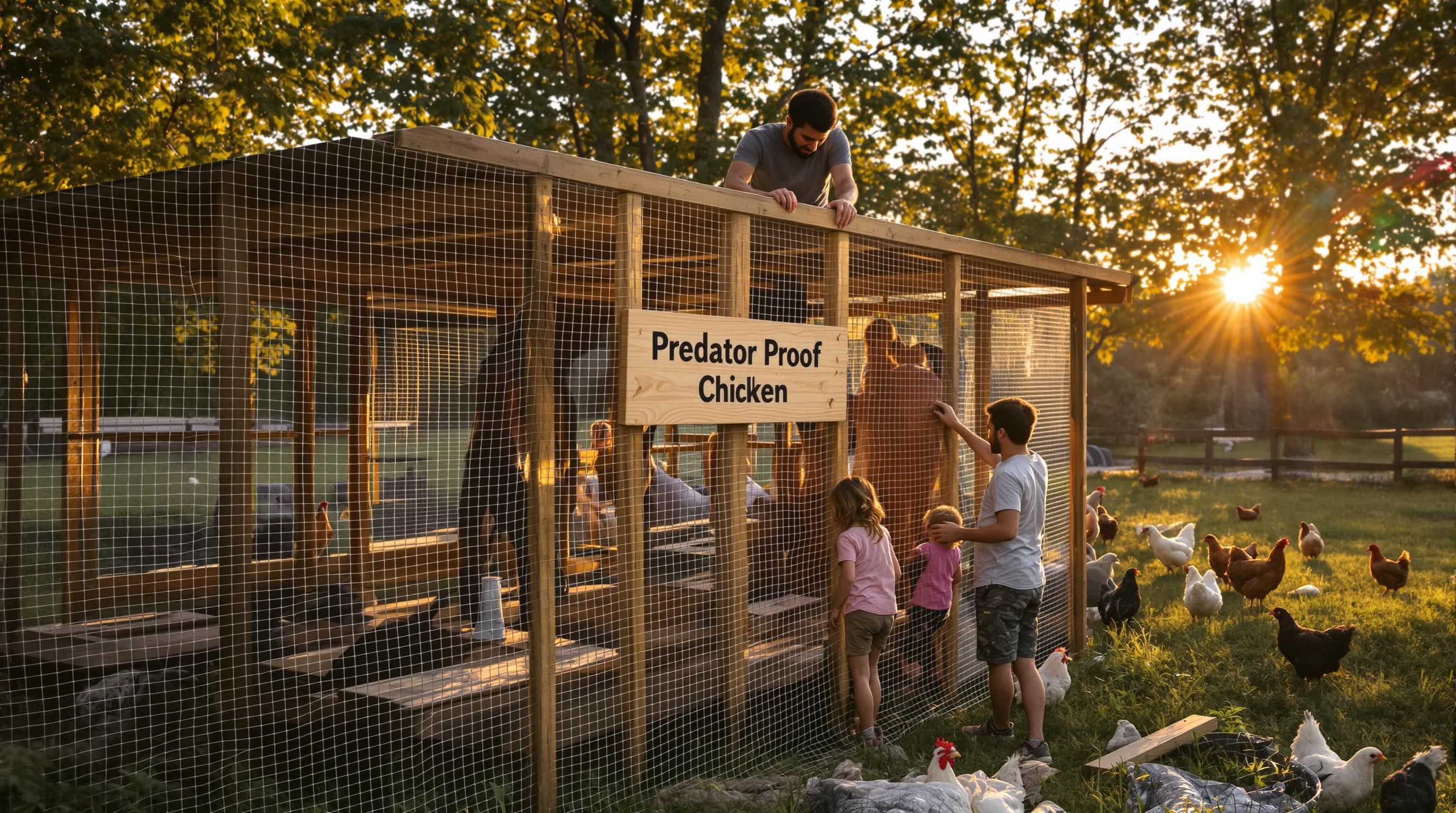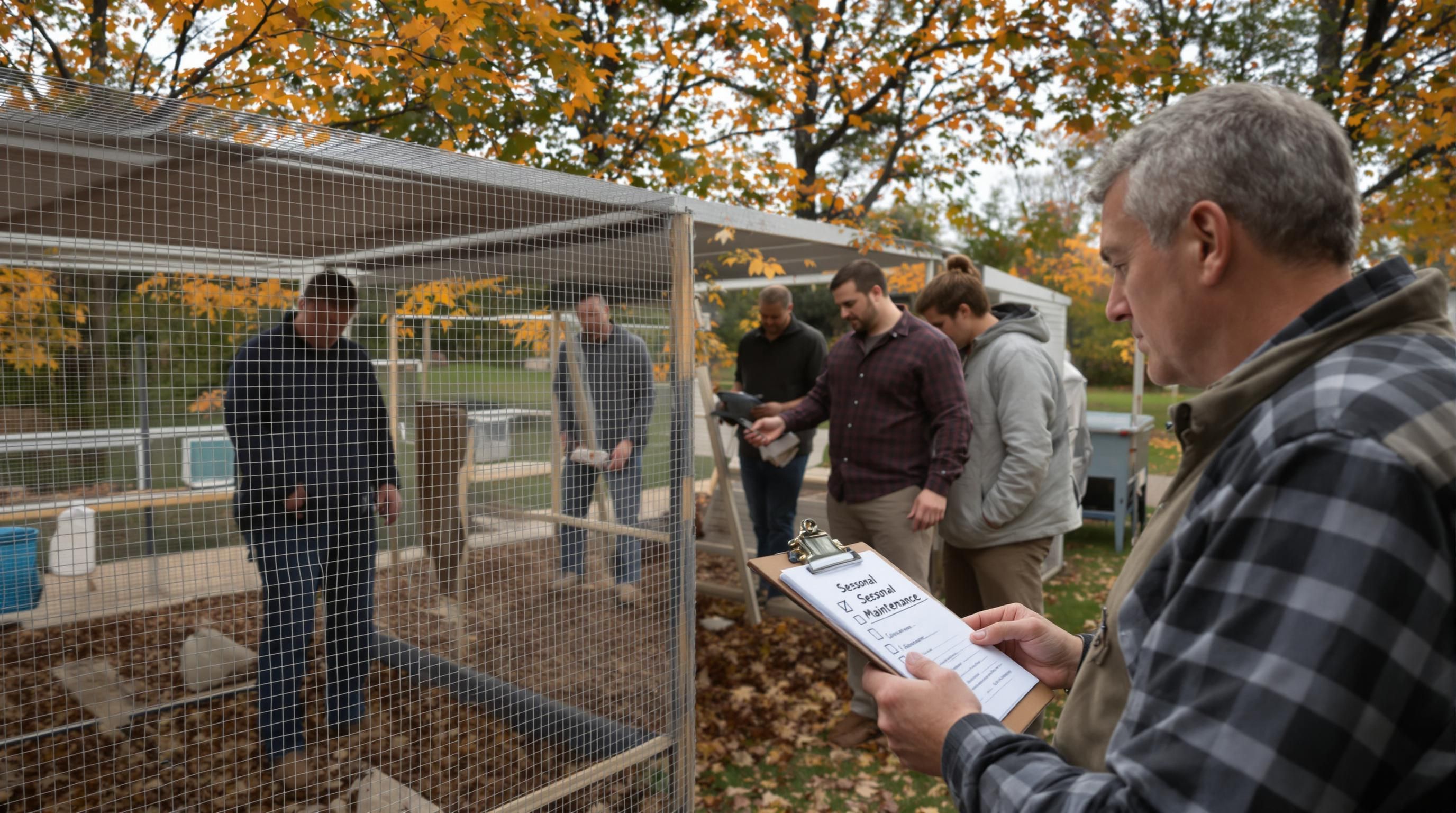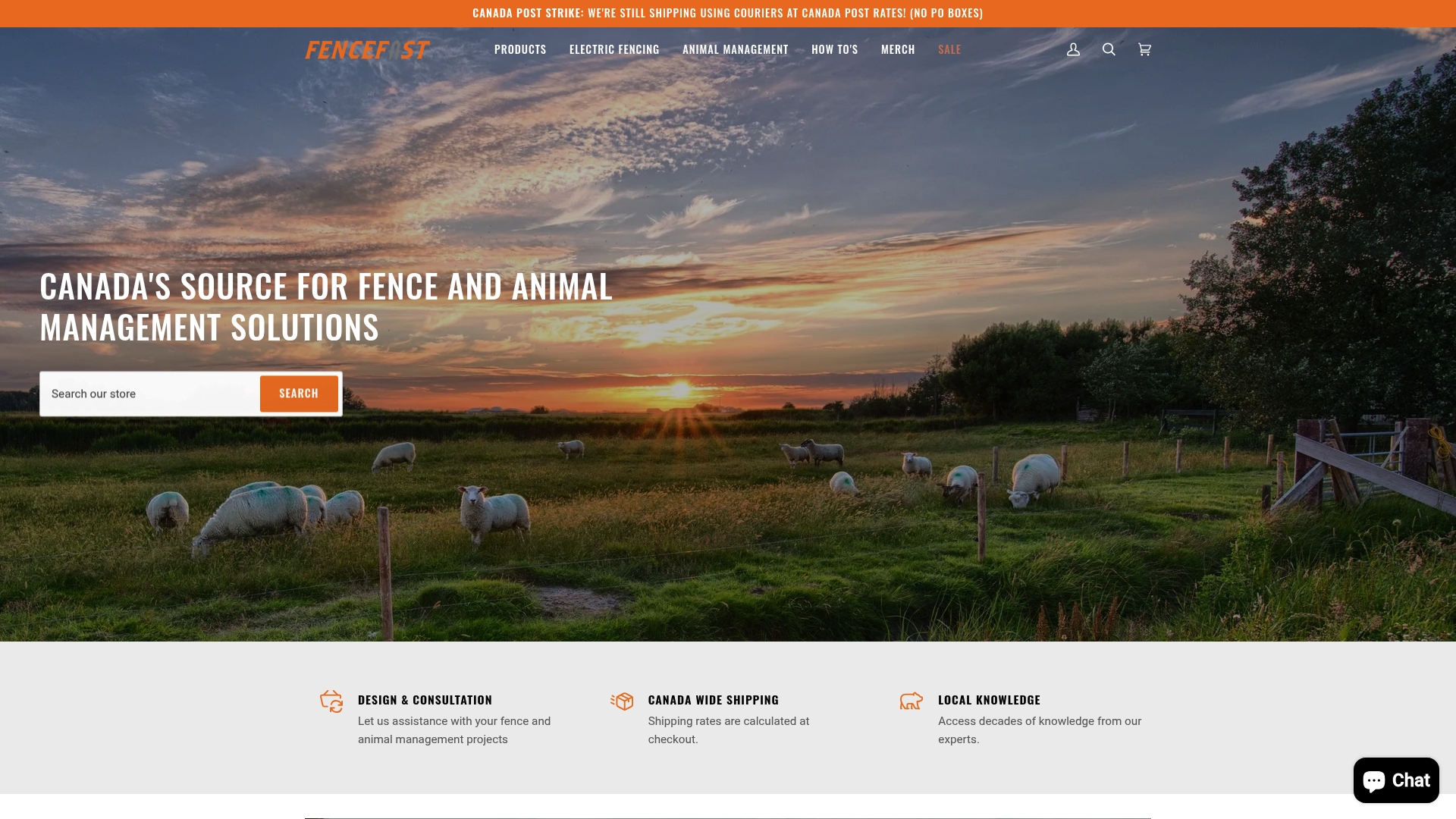
Every backyard flock faces the looming threat of hungry predators, and losing a single chicken can feel devastating. Most people assume throwing up a quick fence or locking the door at night is enough to keep their birds safe. Yet, over 70 percent of chicken losses in the U.S. are blamed on predators finding weak spots in coops or runs. So what truly stops raccoons, hawks, and foxes in their tracks is not brute force but clever design, adaptive strategies, and knowing exactly how your local wildlife thinks.
Table of Contents
- Understanding Local Predators And Risks
- Building Materials And Design For Maximum Protection
- Smart Coop Placement And Perimeter Defenses
- Maintenance Tips To Keep Coops Predator-Proof
Quick Summary
| Takeaway | Explanation |
|---|---|
| Understand local predator threats | Identify specific predators in your area to tailor your protection strategies effectively. |
| Use strong building materials | Opt for galvanized hardware cloth and pressure-treated wood for maximum durability against predators. |
| Implement layered defenses | Combine physical barriers, strategic placement, and active monitoring for a comprehensive protection system. |
| Conduct regular maintenance | Perform quarterly inspections and repairs to maintain the integrity of your chicken coop against predators. |
| Adapt strategies seasonally | Modify your security approach based on seasonal changes in predator behavior and environmental conditions. |
Understanding Local Predators and Risks
Creating predator proof chicken coops starts with understanding the unique threats in your local environment. Different regions face varied predator challenges that can compromise the safety of backyard flocks. Recognizing these potential threats is the first critical step in developing an effective defense strategy for your chickens.
Identifying Common Chicken Predators
Backyard chicken owners encounter a diverse range of predators that pose significant risks to their flocks. According to Virginia Tech’s wildlife experts, predators can be categorized into several key groups that require specific prevention strategies:
-
Ground Predators: Foxes, raccoons, coyotes, and weasels represent the most common ground-based threats. These animals are skilled at finding vulnerabilities in chicken enclosures and can quickly decimate a flock.
-
Aerial Predators: Hawks, owls, and eagles pose significant risks from above. These birds of prey can swiftly attack chickens with little warning, making overhead protection crucial.
-
Nocturnal Hunters: Possums, skunks, and specific owl species become particularly active during nighttime hours, presenting unique challenges for chicken protection.
Here is a summary table categorizing the common chicken predators, their main attack times, and typical prevention strategies:
Identifying key predator threats and their characteristics helps you prioritize your defense strategies.
| Predator Type | Common Examples | Attack Time | Prevention Focus |
|---|---|---|---|
| Ground Predators | Foxes, Raccoons, Coyotes, Weasels | Day/Night | Sturdy wire mesh, buried fencing |
| Aerial Predators | Hawks, Owls, Eagles | Day (hawks), Night (owls) | Overhead protection, covered runs |
| Nocturnal Hunters | Possums, Skunks, Some Owls | Night | Secure latches, motion lighting |
Assessing Local Predator Risks
Effective predator protection requires a nuanced understanding of local wildlife patterns. Massachusetts Division of Fisheries and Wildlife emphasizes the importance of conducting a comprehensive local predator assessment. This involves:
- Researching local wildlife reports and conservation data
- Consulting with local agricultural extension offices
- Observing wildlife activity in your specific area
- Identifying potential entry points and vulnerabilities in existing chicken enclosures
Understanding predator behavior is more than just recognizing potential threats. It involves comprehending their hunting patterns, preferred times of activity, and specific methods of accessing chicken coops. For instance, raccoons are known for their remarkable dexterity and ability to manipulate complex latches, while coyotes might attempt to dig underneath existing barriers.
Chicken owners must recognize that predator risks are not static. Seasonal changes, urban development, and local ecological shifts can dramatically alter predator behaviors and population dynamics. What might work as a protection strategy in one season could become ineffective in another.
The most successful predator proof chicken coops integrate multiple layers of protection. This means combining physical barriers, strategic design elements, and ongoing monitoring to create a comprehensive defense system. Understanding local predators is not just about prevention but about developing a holistic approach to flock safety that adapts to changing environmental conditions.
Remember that each predator presents unique challenges. A solution that works against ground predators might be ineffective against aerial threats. Your local predator proof chicken coop strategy must be as dynamic and adaptable as the wildlife surrounding your property.
Building Materials and Design for Maximum Protection
Designing predator proof chicken coops requires strategic material selection and thoughtful architectural planning. The right combination of materials and design elements can create an impenetrable fortress that protects your flock from various wildlife threats.
Essential Material Considerations
Choosing the right building materials is fundamental to creating a robust chicken coop. Durability, strength, and resistance to potential predator attacks should be the primary considerations. Galvanized wire mesh stands out as a critical component in predator defense. Unlike standard chicken wire, high-quality galvanized hardware cloth with small mesh sizes (1/4 inch to 1/2 inch) provides superior protection against rodents, snakes, and small predators.
Wood selection plays a crucial role in coop construction. Pressure-treated lumber offers enhanced durability and resistance to rot and pest intrusion. Cedar and redwood are excellent natural alternatives, providing inherent resistance to decay and insects. When selecting wood, prioritize thick, sturdy boards that can withstand potential predator attempts to break through.
Strategic Design Elements
The physical structure of the coop matters as much as the materials used. University of California Agriculture and Natural Resources recommends implementing multiple layers of protection through intelligent design. This includes:
- Reinforced Floor Systems: Implement solid flooring or buried wire mesh extending at least 12 inches underground to prevent digging predators from accessing the coop.
- Robust Roof Structures: Use solid, well-secured roofing materials that eliminate potential entry points for climbing or flying predators.
- Secure Locking Mechanisms: Install predator-resistant locks that cannot be manipulated by raccoons or other dexterous wildlife.
Electric fencing provides an additional layer of protection for more challenging predator environments. National Poultry Improvement Plan suggests that well-designed electric fencing can create an effective deterrent for larger predators like coyotes and foxes.
Ventilation presents a unique challenge in predator proof chicken coop design. Proper airflow is essential for chicken health, but ventilation openings must be carefully constructed to prevent predator access. Use fine mesh screens with small openings that allow air circulation while blocking entry points for small predators.
Consider the total enclosure design as a comprehensive protection system. Chickens need both a secure indoor sleeping area and a protected outdoor run. The outdoor area should have overhead coverage to prevent aerial predator attacks and sturdy perimeter fencing that extends both above and below ground level.

Material durability extends beyond initial construction. Regular maintenance and inspection are crucial. Look for signs of wear, potential weak points, or damage that could compromise the coop’s structural integrity. Annual or semi-annual comprehensive inspections can identify and address potential vulnerabilities before they become serious security risks.
Predator proof chicken coops are not about creating an impenetrable fortress but developing a smart, adaptive protection system. By combining high-quality materials, intelligent design, and ongoing maintenance, chicken owners can create a safe environment that significantly reduces predation risks.
Smart Coop Placement and Perimeter Defenses
Successful predator protection for chickens extends far beyond the coop itself. Strategic placement and comprehensive perimeter defenses play a critical role in creating a secure environment for your flock. Understanding how to position and fortify your chicken habitat can significantly reduce predation risks.
Strategic Location Selection
Choosing the right location for your predator proof chicken coop is the first line of defense. Massachusetts Division of Fisheries and Wildlife recommends selecting an area with multiple natural and constructed advantages. Ideal locations offer:
- Clear Visibility: Position the coop where you can easily monitor activity and predators have limited hiding spots.
- Natural Barriers: Utilize existing landscape features like slopes, dense vegetation, or rock formations that naturally discourage predator approach.
- Proximity to Human Activity: Predators are less likely to attack areas with frequent human presence.
Comprehensive Perimeter Protection
Virginia Cooperative Extension emphasizes the importance of a multi-layered perimeter defense strategy. This involves creating physical and psychological barriers that deter wildlife from approaching your chicken habitat.
Key perimeter defense techniques include:
-
Buried Fencing Technique
- Extend fencing at least 12 inches underground
- Angle bottom of fence outward by 6 inches to prevent digging
- Use heavy-gauge wire mesh with small openings
-
Overhead Protection
- Install crisscrossed wires or mesh to disrupt aerial predator flight paths
- Create covered runs that prevent hawks and owls from diving
-
Landscape Management
- Remove potential predator hiding spots near the coop
- Maintain clear zones around the perimeter
- Trim vegetation that could provide cover for approaching wildlife
Below is a table summarizing perimeter defense techniques and their primary benefits for easy comparison.
| Perimeter Defense | Method | Main Benefit |
|---|---|---|
| Buried Fencing | Fence 12" underground, angled outward | Stops digging predators |
| Overhead Protection | Crisscrossed wires/mesh, covered runs | Blocks aerial attacks |
| Landscape Management | Remove cover, trim vegetation, clear zones | Reduces hiding spots for wildlife |
| Electric Fencing | Install low-voltage around perimeter | Deters larger predators |
| Motion Lighting/Deterrents | Motion lights, noise makers, reflectors | Discourages nocturnal predators |
Additional Deterrent Strategies
Beyond physical barriers, consider integrating additional deterrent methods. Motion-activated lighting can startle nocturnal predators, while strategic noise makers or reflective objects can create an unpredictable environment that discourages consistent predator approaches.
Electric fencing represents another advanced perimeter defense. Low-voltage systems can effectively discourage larger predators without causing permanent harm. These systems work by delivering a short, surprising shock that teaches predators to avoid the protected area.
Remember that predator defenses are not static. Regular assessment and adaptation of your perimeter strategy are crucial. Wildlife behavior changes with seasons, local development, and population dynamics. What works effectively one year might require modification the next.
Effective predator proof chicken coops integrate smart placement, robust perimeter defenses, and ongoing vigilance. By creating a comprehensive protection system that considers location, physical barriers, and adaptive strategies, chicken owners can significantly reduce the risk of predation and ensure their flock’s safety.
Maintenance Tips to Keep Coops Predator-Proof
Maintaining a predator proof chicken coop is an ongoing process that requires consistent attention and proactive strategies. Regular maintenance is crucial in preserving the structural integrity and protective capabilities of your chicken habitat.
Routine Structural Inspections
Consistent and thorough inspections form the backbone of effective coop maintenance. Experts recommend conducting comprehensive checks at least quarterly, focusing on potential vulnerability points that predators might exploit. Look for signs of wear, damage, or potential entry points such as:
- Wire Mesh Integrity: Check for rust, holes, or loose connections in wire mesh and hardware cloth
- Wood Condition: Inspect wooden structures for rot, cracks, or structural weakening
- Foundation Stability: Examine ground-level connections for signs of digging or potential underground breaches
Small vulnerabilities can quickly become major security risks. A tiny hole or loose board might seem insignificant but can provide an entry point for determined predators like weasels, rats, or snakes.
Comprehensive Repair and Reinforcement Strategies
University of California Cooperative Extension recommends implementing a systematic approach to coop maintenance. This involves not just identifying issues but addressing them promptly and effectively:
- Replace damaged wire mesh immediately using galvanized hardware cloth
- Seal wood cracks and gaps with predator-resistant materials
- Reinforce door hinges and locks to prevent manipulation
- Apply protective treatments to wooden structures to prevent decay
Seasonal Maintenance Considerations
 Predator behaviors and risks change with seasonal variations. National Wildlife Control Operators Association suggests adapting your maintenance strategy to seasonal challenges:
Predator behaviors and risks change with seasonal variations. National Wildlife Control Operators Association suggests adapting your maintenance strategy to seasonal challenges:
- Spring: Inspect for winter damage, check for new animal trails or nesting areas near the coop
- Summer: Focus on ventilation while maintaining security, watch for increased insect and small predator activity
- Fall: Reinforce structures before winter, seal potential entry points
- Winter: Monitor snow accumulation that might create new access routes
To help you keep track of seasonal maintenance priorities, here’s a table outlining recommended focus areas by season:
| Season | Key Focus Areas |
|---|---|
| Spring | Inspect for winter damage, new animal trails/nesting areas |
| Summer | Enhance ventilation while securing coop, monitor insect/small predator activity |
| Fall | Reinforce structure before winter, seal new entry points |
| Winter | Check snow accumulation, ensure no new access routes form |
Additional maintenance strategies include regular cleaning to remove food debris that might attract predators, trimming vegetation around the coop to eliminate hiding spots, and ensuring proper drainage to prevent moisture buildup that could weaken structural materials.
Technology can also play a role in modern predator proof chicken coop maintenance. Motion-activated cameras and sensors can help you monitor potential threats and identify maintenance needs before they become critical security issues.
Remember that maintenance is more than just physical repair. It is about creating an adaptive, responsive system that evolves with your local ecosystem. Successful predator protection requires a holistic approach combining structural integrity, strategic design, and ongoing vigilance.
Chicken owners who invest time in consistent, thorough maintenance significantly reduce the risk of predation. By treating your coop as a dynamic system that requires regular attention, you create a safer, more secure environment for your flock.
Frequently Asked Questions
What are the most common predators that threaten backyard chickens?
Common predators include ground threats like raccoons, foxes, and coyotes, as well as aerial predators such as hawks and owls. In addition, nocturnal hunters like possums and skunks can pose risks to your flock.
How can I identify predator risks in my area?
To assess predator risks, research local wildlife by checking conservation data, consulting agricultural extension offices, and observing animal activity around your property to recognize potential entry points.
What materials should I use to build a predator-proof chicken coop?
For maximum protection, use galvanized hardware cloth instead of standard chicken wire, and select pressure-treated wood for the structure. Ensure that the coop is reinforced with secure locks and strong roofing materials.
How often should I inspect my chicken coop for maintenance?
Regular inspections should be conducted at least quarterly. Focus on checking for wear and tear on the wire mesh, wood condition, and any potential digging or entry points to maintain a predator-proof environment.
Ready to Make Your Chicken Coop Truly Predator Proof?
After learning about the real dangers that threaten backyard flocks—from sneaky raccoons to digging coyotes—it is clear that a weak fence or a simple lock is not enough. Your most important goal is to keep every chicken safe by building a fortress that truly puts an end to sleepless nights and lost birds. Durable materials like galvanized wire mesh and layered defenses are some of the key solutions highlighted in the guide, but sourcing reliable, farm-grade equipment is often a challenge for Canadian owners.
Why trust your flock’s safety to chance? At FenceFast.ca, you get more than just fencing supplies. You get access to a huge range of predator-resistant wire mesh, secure electric fencing systems, and expert advice to match your unique setup. All our products are tailored for agricultural use and rural environments across Canada, so you can spend less time worrying and more time enjoying your healthy chickens. Want extra tips or need help choosing the right components? Visit our main site for trusted guidance and easy ordering. Find everything you need today and start building the ultimate predator proof chicken coop before the next threat arrives.

Do not wait until you suffer a loss. Browse FenceFast.ca now and discover how professional-grade fencing and animal management supplies can protect your flock all year round. Shop today to give your chickens the safe home they deserve.
Recommended
-
[
Gallagher S200 Portable Solar Fence Energizer 2.0 joules – FenceFast Ltd.
](https://fencefast.ca/products/gallagher-solar-fence-energizer-s200)
-
[
Gallagher KIWITAH 3 X Grounding Kit for Large Energizer – FenceFast Ltd.
](https://fencefast.ca/products/gallagher-kiwitah-ground-stake-kit)
-
[
Plastic Drum with Lid - 15 Gallon, Open Top, Blue – FenceFast Ltd.
](https://fencefast.ca/products/plastic-drum-with-lid-15-gallon-open-top-blue)
-
[
Lamb Packer – FenceFast Ltd.
